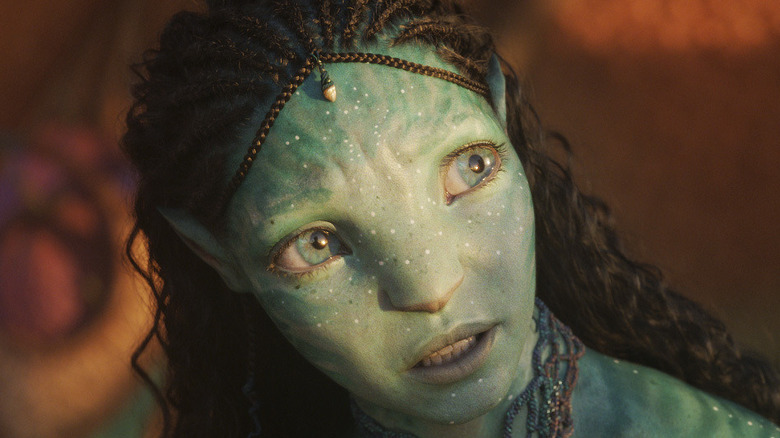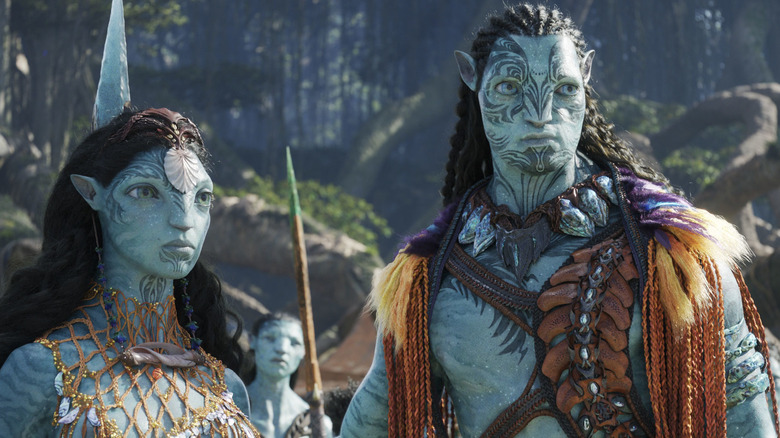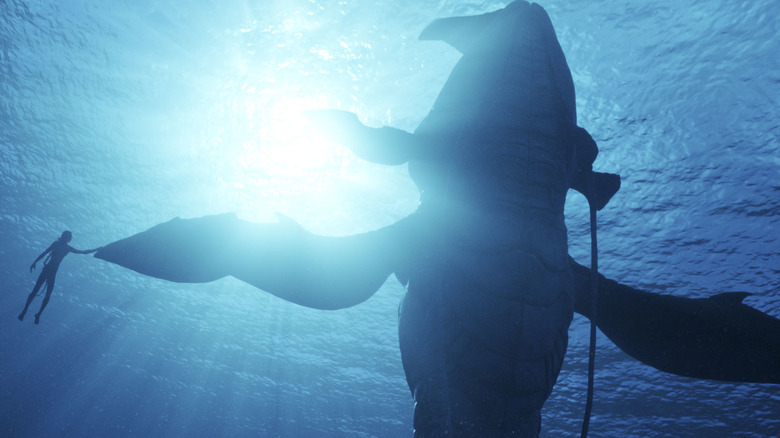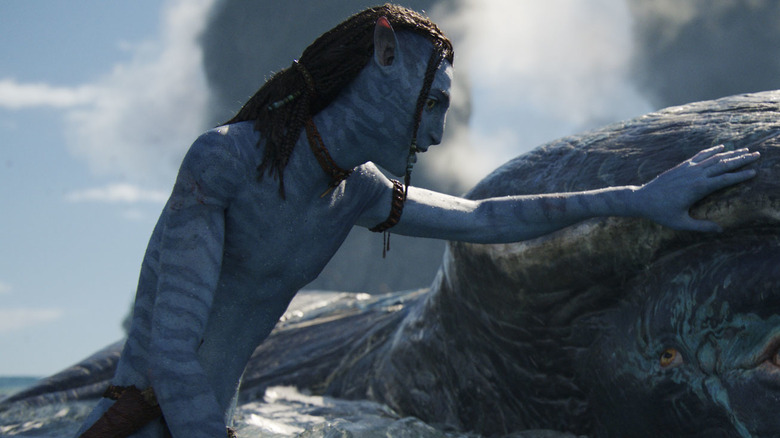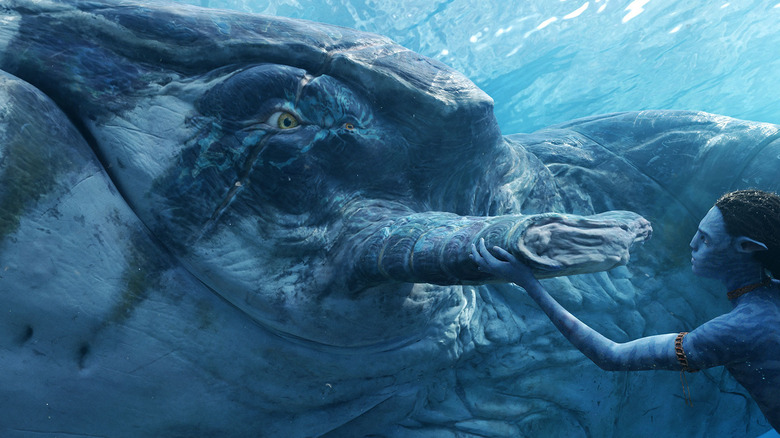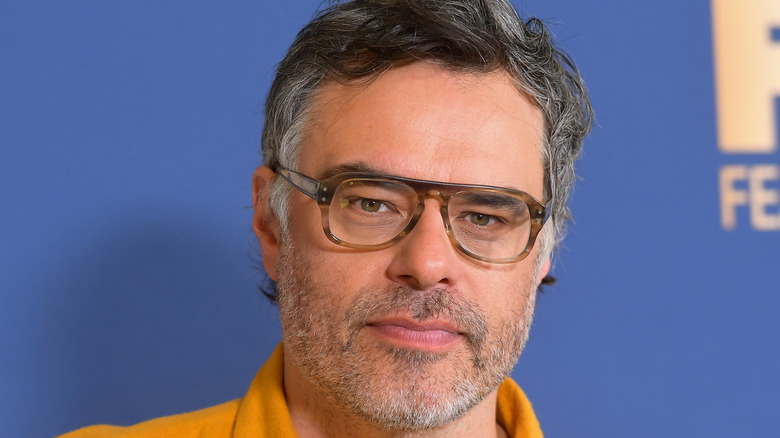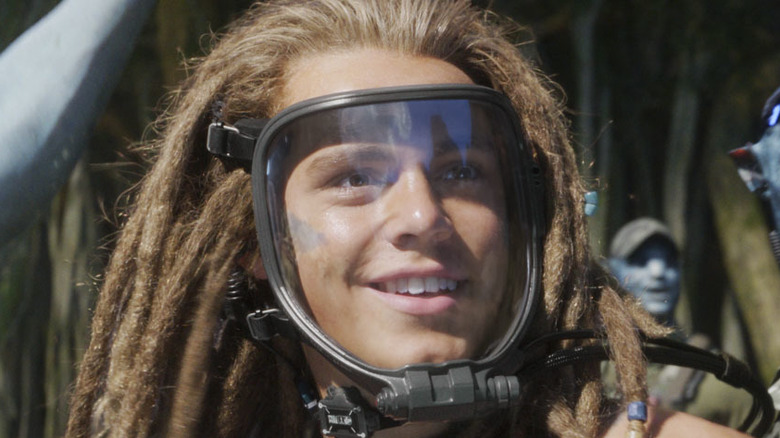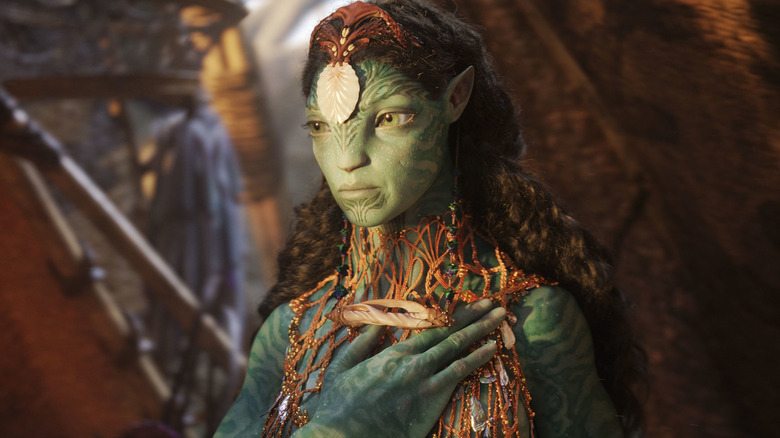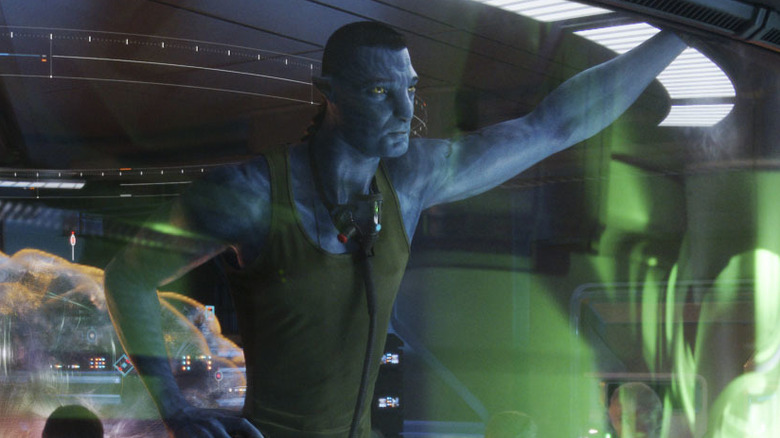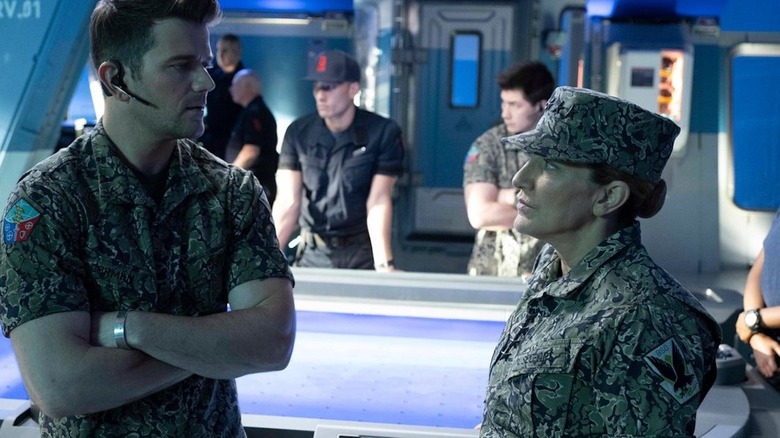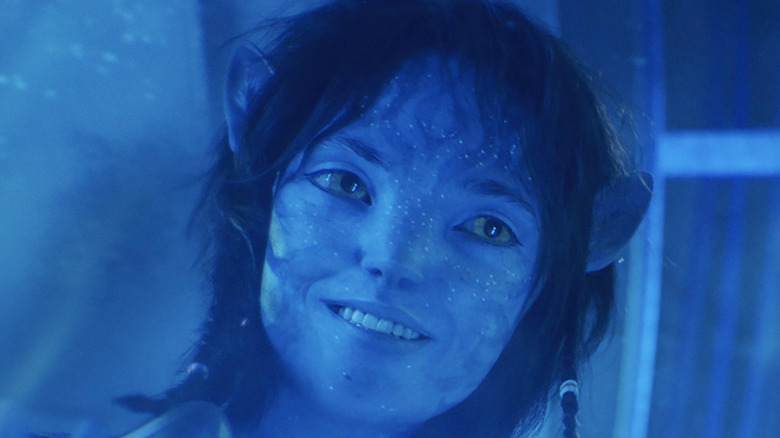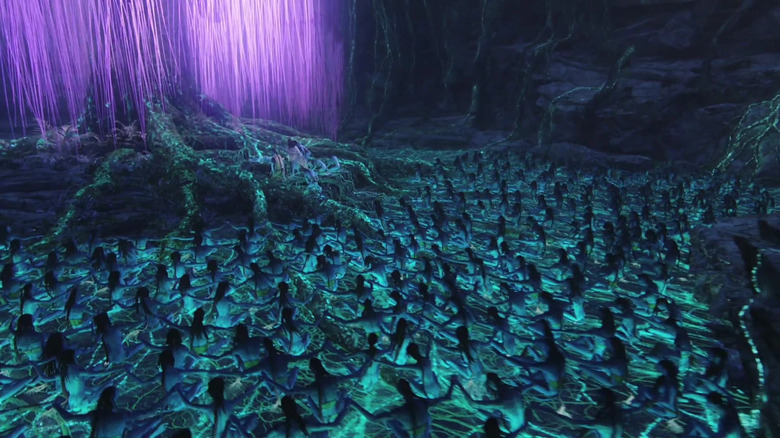Characters In Avatar: The Way Of Water With More Meaning Than We Realized
It took 13 years to follow up on 2009's "Avatar," an understandable wait for the highest-grossing movie of all time, as well as the new benchmark in CGI and motion-capture technology. Luckily, "Avatar: The Way of Water" has finally been released, and fan reactions have proven it to be nearly everything fans had hoped. The trip back to Pandora is even more visually impressive than the first, with the reefs and seas that sustain the Metkayina people as paradoxically fantastical and realistic as any that have ever been on screen. In addition, backing up all the flash and 3D is an ever-expanding and evolving cast of characters who add some much-needed (and in many cases, ironic) humanity.
The many characters in the Avatar franchise, both human and Na'vi, show genuine growth from the first film to the second, and it's becoming clearer with each installment that they have a tremendous amount in store for them in future iterations. The world of Pandora becomes more fleshed out with each movie, adding new heroes, villains, and entirely new species, many of which potentially mean a lot to the franchise going forward. Here, we'll dive into the rich waters of the characters in "Avatar: The Way of Water" with more meaning than we realized.
The Metkayina
One of the brightest highlights of the original "Avatar" was getting to know the Na'vi. Not only was the general plot of the movie about humanity's first, fumbling steps with the species, and not only was protagonist Jake Sully's (Sam Worthington) entire arc about becoming close to the Na'vi, but the greatest promise of the franchise's premise lay in the feline species and their charming emotionality. That is one of several reasons why the introduction of the Metkayina Clan of Na'vi means so much to both "Avatar: The Way of Water" and the franchise moving forward.
We knew from the existence and lore of the Toruk Makto in the first movie that there were other Na'vi clans, but we never got to see them in detail. Being set almost entirely in Metkayina territory, the second film finally allows us to see how other Na'vi live, and it is pretty wildly different. In addition to their many differences in lifestyle, the Metkayina are anatomically different from the forest-dwelling Na'vi — strikingly so. They are differently colored, possess more efficient lungs, thicker, fin-like arms and legs, and even stronger, fin-like tails. The largest phenotypic differences among humans pale in comparison to these, implying that the Na'vi clans likely split apart millions of years ago (as opposed to humans, whose most recent common ancestor likely lived 100,000-200,000 years ago). Impressively, even after all that time and evolution, the many Na'vi clans still live in relative peace.
The tulkuns
If the insider look at the lives of the Metkayina Na'vi in "Avatar: The Way of Water" opened the doors to a larger Pandora, then the introduction of the tulkuns blew that door, its hinges, and the surrounding walls clean off. Pandora was special enough when it seemed to be simply an Earth-like exomoon with its own sentient species, but now that another, entirely unrelated sentient species exists in the form of the whale-like tulkuns, Pandora means so much more.
For one thing, the tulkuns force a major change to modern hypotheses of astrobiology — sentience is evidently more common than we ever imagined, and clearly comes in many shapes and sizes. But for another, more narrative-related point, the tulkuns are almost certainly going to play a huge role in future "Avatar" movies. Perhaps the most central theme in "Avatar: The Way of Water" (alongside competing concepts of fatherhood) is the relationship between pacifism and morality. Jake chooses to give up his fight and flee the RDA, and although that sounds noble in a sense, it simply ends up bringing his war to a new clan. The tulkuns are symbolic stand-ins for Jake, choosing to forbid all violence in their culture regardless of motivation, which ultimately results in many of their deaths. As the rebellious, aggressive acts of Lo'ak Sully (Britain Dalton) and Payakan reveal, sometimes violence — in the right context and for the right reasons — is actually the answer.
Lo'ak
Among the four Sully children, "Avatar: The Way of Water" makes it clear that some are destined for more than others. Aside from the obvious point to make, which is that Neteyam's (Jamie Flatters) death most likely rules him out of any major roles in the franchise's future, Kiri (Sigourney Weaver) and Lo'ak are shown to possess unique gifts that make them important figures in the coming conflicts. For Lo'ak that gift comes in the form of the spirit-bond he is able to form with Payakan, the lone tulkun who was outcast for fighting back against the RDA.
Lo'ak was raised as an underdog, the second son who was always in the shadow of Neteyam, making him more flawed, tragic, and sympathetic than his brother. Partially because of that misfit childhood, Lo'ak is well-suited to understanding and bonding with Payakan. The two meet as mutual misfits, both understanding of the other's challenges, and both more prepared than their collectively-minded peers to combat (literally and metaphorically) the RDA's increasing threat. They're the stuff that folk heroes are made of, and supporting that notion is the rumored leak of future Avatar movie titles, one of which is allegedly "Avatar: The Tulkun Rider" (via IndieWire).
Payakan
Despite the Sully family's central place in the overall story of the "Avatar" movies, much of what makes them so special is the partnerships and bonds they form with others. That makes a figure like Lo'ak, who is likely to become one of the next great heroes, almost impossible to mention without also recognizing his partner-in-crime(-prevention), Payakan.
Between Lo'ak and Payakan, it is the massive tulkun who has more to lose, more to gain, and more RDA equipment to smash than Lo'ak, and his contribution to the war cannot be overlooked. Payakan's story is tragic, one of an individualist who acted against his society's laws only to save his friends and family. By bonding with Lo'ak and helping the Sully family repel the RDA from the Metkayina's waters — in fact, doing the majority of the work all by himself — Payakan proves himself a more valuable asset than all of his fellow tulkuns combined, as well as a much more apparent hero. If there is any one scene in "Avatar: The Way of Water" that went too far, it was the brutal murder of a mother tulkun (and by extension, her calf), and the only tulkun with the ability and drive to prevent this from happening again is Payakan.
Dr. Garvin
A high-profile addition to the cast for "Avatar: The Way of Water" is Jemaine Clement in the role of Dr. Ian Garvin, a marine biologist and begrudging RDA employee (or at least contractor). Though he only minimally affected the movie's plot, Dr. Garvin means a lot to its major theme, the franchise's theme as a whole, and potentially, the characters going forward.
Dr. Garvin helps introduce a number of features to the "Avatar" universe, not least of which is the hyper-valuable brain fluid possessed by the tulkuns. According to Garvin and his fellow scientists/poachers, the fluid is the most valuable substance known to humanity, mainly due to a mysterious and unique property it possesses that permanently stops humans again. In lieu of unobtainium, the tulkun brain fluid is the main driving force for the RDA's continued invasion of Pandora. Perhaps more importantly, Dr. Garvin serves to teach — or at least try to teach — Colonel Quaritch (Stephen Lang) and other members of the RDA the true complexities of the tulkuns and their culture. With the tulkuns set to be the heavies in the war against the RDA, Dr. Garvin might end up the connecting force between the creatures and the more sympathetic humans.
Spider
In addition to their four children, Jake and Neytiri (Zoe Saldana) also care for what Jake calls "more of a stray cat," the human child named Spider (Jack Champion). More than any other character in "Avatar: The Way of Water," Spider's very existence is packed with meaning. In a way, he fits the trope of a child of two worlds — a human raised on Pandora by the Na'vi, fluent in their language and immersed in their culture — and is therefore virtually guaranteed to help bring about a much-needed peace in the franchise's future. But Spider is more than that, because he's not just human, his father is Colonel Quaritch.
Franchise architect James Cameron is a well-known environmentalist, and that personal philosophy shines brightly through the "Avatar" films. That makes the most likely and logical conclusion to the films, assuming a happy ending is the goal, is peace between humanity, the Na'vi, the tulkuns, and every other living thing on Pandora and elsewhere. Assuming that to be true, then no character, not Jake, not Lo'ak, not Kiri, nor anyone, is as well-positioned to become the ultimate hero as Spider. Spider is Tarzan, Luke Skywalker, and Boromir all rolled into one, which gives him more meaning than most.
Ronal
The Metkayina are ruled by a royal family, led by their patriarch, Tonowari (Cliff Curtis). Of course, as Jake and Neytiri make clear, Tonowari himself has a leader: his wife, Ronal (Kate Winslet). Not only is she the power behind the throne, but she is also the clan's official tsahìk, or spiritual leader.
It's immediately apparent from the way that the Metkayina treat Tonowari and Ronal that the pair are respected in their community, and that their word is law. The Metkayina are also an unusually powerful clan, with military strength on the land, sea, and air, as well as a strong alliance with the tulkuns. With Ronal as the head of such a formidable force, that makes her potentially the greatest threat to the RDA and to humanity's presence on Pandora in general.
On the real-world side of things, Ronal's appearance in at least one more "Avatar" is confirmed, and hinted at beyond that. Pictures of Winslet filming the third installment have been posted online through official channels, one of which comes with a story — while filming one underwater scene for the third movie, Winslet held her breath for an astonishing seven minutes and fourteen seconds. Not only is the feat impressive, it also hints at a comparatively impressive feat by Ronal on screen.
Colonel Quaritch
Believe it or not, death was not the end for Colonel Quaritch. Even though the Marine died at the end of "Avatar," shot through the chest by two of Neytiri's arrows, he lived on via a recombinant — his own Na'vi avatar. The irony in his new life as a Na'vi is obvious, and becomes even more so when he engages in tsaheylu, or neural bonding, with his own banshee, a major rite of passage for native Na'vi. Even reborn as a Na'vi, he spends "Avatar: The Way of Water" seeking the same vengeance against Jake Sully he sought for most of the first movie. Even so, his tough outer shell may end up a bit softened by the film's end, thanks mainly to the saintly compassion of Spider, as well as — just maybe — his newfound connection with the Pandoran biosphere.
Quaritch was a meaningful character when he was a relatively simple human villain. If he ends up a recombinant Na'vi who helps bring down the RDA from the inside, or — in a massive evolution of character — fostering peace between the RDA and Na'vi, he'll go down as one of the franchise's most meaningful characters ever.
General Ardmore
With Colonel Quaritch in the nascent stages of a potential character arc that may just end with him siding with the Na'vi — in a way now, his own people — a new top villain needs to arise to take his place. And even if Quaritch remains arc-less and every bit the two-dimensional villain he first appeared to be, a five-movie series will need more to sustain its conflict. That's where General Ardmore (Edie Falco) comes in, the new big bad introduced in "Avatar: The Way of Water," and based on rank alone, she has more to throw at the Na'vi and their allies than Quaritch ever could.
In terms of the Marine Corps hierarchy, Ardmore outranks Quaritch by a long shot. While a typical Colonel like Quaritch might command a Regiment of around 2,000 Marines, a General like Ardmore would lead an entire Marine Division of 6,000+. On top of that, The official Avatar Twitter account revealed that Ardmore is the new head of the RDA's Pandora missions, making her definitively the biggest thorn in Pandora's side. Even more potentially meaningful is that General Ardmore seems to be free of the over-the-top machismo that plagues (or plagued) Quaritch and his lieutenants, which almost certainly allows her tactical decision-making to be clearer, colder, and deadlier.
Kiri
There is something special about Jake and Neytiri's eldest daughter, Kiri — starting with the fact that she's not their biological daughter. According to Cameron, Kiri's biological mother is the Na'vi avatar of Grace Augustine (also Sigourney Weaver), possibly while the avatar was already brain-dead, and Kiri's father remains unknown (via Entertainment Weekly). On top of her unusual origins, she also possesses uniquely powerful empathic powers, and they undoubtedly mean a lot to the next few Avatar films.
In "Avatar: The Way of Water," Kiri demonstrates her powers in a number of ways, often by communicating with animals more deeply and intuitively than any other Na'vi. Often, however, she even demonstrates the ability to control animals around her, such as when she takes command of a pair of giant sea anemones and guides them as they pull two RDA soldiers down into the inky depths. At one point, Kiri even reveals to her father that she can hear and feel Eywa herself, and though that is later written off by the scientist Norm (Joel David Moore) as a side effect of her epilepsy, it seems more likely than not that she isn't just hallucinating. We've seen her ability to speak with and control the life around her, and we've seen the all-encompassing neural network shared by the Pandoran biosphere, so the idea that she can speak with the planet itself, or even its deity, is not so far-fetched.
Eywa
As surprising as it may be, "Avatar: The Way of Water" may have actually confirmed the existence of the Na'vi chief deity, Eywa. The first movie explained the vast network of electro-chemical connections shared by all living things on Pandora, which the Na'vi refer to as Eywa. Through the connection, all living things can communicate and share experiences like memories. The second movie, however, doesn't just show creatures communicating — it demonstrates emergent properties on behalf of the network itself; in other words, evidence of artificial intelligence.
With young Kiri able to hear and feel not just the living things around her but the sum totality of that life itself, and then prove her feelings by manipulating that totality, she essentially proves that the network has become more than just a system of connections — it has learned from its massive dataset, and in doing so become a discrete entity. In other words, the Pandoran neural network is Eywa, Eywa is real, and Eywa has at least a rudimentary mind of her own. While we've seen alleged evidence of Eywa's personality before, most notably when she seemingly spurred the forest creatures to aid the Na'vi in their battle at the end of the first movie, we can now confirm (or as close as we can get to it) that Eywa is not just a name to be applied to unlikely acts of fate. She's a real being with real feelings, and through Kiri, we may yet hear her speak.
